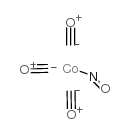14096-82-3
| Name | cobalt tricarbonyl nitrosyl |
|---|---|
| Synonyms |
Cobalt,tricarbonylnitrosyl-,(T-4)
TRICARBONYLNITROSYLCOBALT Co(CO)3NO EINECS 237-945-5 MFCD00016014 |
| Boiling Point | 50ºC |
|---|---|
| Melting Point | -11ºC |
| Molecular Formula | C3CoNO4 |
| Molecular Weight | 172.97000 |
| Exact Mass | 172.91600 |
| PSA | 29.43000 |
|
Section 1: Product Identification Chemical Name:Cobalt tricarbonyl nitrosyl CAS Registry Number:14096-82-3 Formula:Co(CO)3NO EINECS Number:237-945-5 Chemical Family:metal carbonyl complexes Synonym:none
Section 2: Composition and Information on Ingredients IngredientCAS NumberPercentACGIH (TWA)OSHA (PEL) Title Compound14096-82-3100%0.02mg/m3no data Section 3: Hazards Identification Harmful by inhalation, in contact with skin and if swallowed. Inhalation can lead to headaches and dizziness. Emergency Overview: Prolonged exposure can lead to convulsions and coma. Primary Routes of Exposure:Ingestion, inhalation Eye Contact:May cause mild irritation to the eyes. Skin Contact:Harmful in contact with skin. May cause mild irritation to the skin. Inhalation:Harmful through inhalation. Inhalation could lead to dizziness and headache. Ingestion:Harmful if swallowed. Harmful by inhalation, in contact with skin and if swallowed. Inhalation can lead to headaches and dizziness. Acute Health Affects: Prolonged exposure can lead to convulsions and coma. Chronic Health Affects:No information on long term exposure. NTP:No IARC:Yes OSHA:No SECTION 4: First Aid Measures Immediately flush the eyes with copious amounts of water for at least 15 minutes. A victim will need Eye Exposure: assistance in keeping their eye lids open. Get immediate medical attention. Wash the affected area immediately with water. Remove contaminated clothing if necessary. Seek medical Skin Exposure: assistance if irritation persists. Remove victim to fresh air immediately. Keep the victim lying down and warm. Give oxygen as soon as Inhalation: possible. If shock occurs, respond with appropriate first aid. Transport the victim to a hospital. Seek medical attention immediately. Keep the victim calm. Give water to dilute the toxin (only if conscious). Ingestion: Induce vomiting only if directed by medical personnel. SECTION 5: Fire Fighting Measures Flash Point:no data Autoignition Temperature:no data Explosion Limits:no data Extinguishing Medium:carbon dioxide, dry chemical or foam If involved in a fire, fire fighters should be equipped with a NIOSH-approved positive pressure self-contained Special Fire Fighting Procedures: breathing apparatus. Hazardous Combustion andcarbon monoxide, carbon dioxide, and cobalt oxides. Decomposion Products: Unusual Fire or Explosion Hazards: Flammable liquid. No unusual fire or explosion hazards. SECTION 6: Accidental Release Measures Small quantities can be mixed with sodium carbonate or vermiculite and swept up. If large quantities are Spill and Leak Procedures: spilled, and ventilation is not available, personnel should be fitted with a self- contained breathing apparatus. SECTION 7: Handling and Storage Handling and Storage: SECTION 8: Exposure Controls and Personal Protection Eye Protection:Always wear approved safety glasses when handling chemical substances. Skin Protection:Wear protective clothing and gloves. Consult with glove manufacturer to determine the proper type of glove. Ventilation:This product should be handled in an efficient fume hood. If ventilation is not available a respirator should be worn. The use of respirators requires a Respirator Respirator: Protection Program to be in compliance 29 CFR 1910.134. Ventilation:This product should be handled in an efficient fume hood. Additional Protection:No additional protection required. SECTION 9: Physical and Chemical Properties Color and Form:dark red liq. Molecular Weight:172.97 Melting Point:no data Boiling Point:50°C Vapor Pressure:no data Specific Gravity:1.47 Odor:musty odor Solubility in Water:Insoluble SECTION 10: Stability and Reactivity Stability:air sensitive, (store cold) Hazardous Polymerization:no hazardous polymerization Conditions to Avoid:prolonged contact with air. Incompatibility:Oxidizing agents and halogens Decomposition Products:carbon dioxide, carbon monoxide, cobalt oxides. SECTION 11: Toxicological Information RTECS Data:No specific information available on this product. Carcinogenic Effects:Possible carcinogen (as Co) Mutagenic Effects:No data available Tetratogenic Effects:No data available SECTION 12: Ecological Information Ecological Information:No information available. SECTION 13: Disposal Considerations Disposal:Dispose of this material according to local, state and federal regulations. SECTION 14: Transportation Shipping Name (CFR):Flammable liquids, toxic, N.O.S. Hazard Class (CFR):3 Additional Hazard Class (CFR):6.1 Packaging Group (CFR):II UN ID Number (CFR):UN# 1992 Shipping Name (IATA):Flammable liquid, toxic, N.O.S. Hazard Class (IATA):3 Additional Hazard Class (IATA):6.1 Packaging Group (IATA):II UN ID Number (IATA):UN# 1992 SECTION 15: Regulatory Information TSCA:Not listed in the TSCA inventory. SARA (Title 313):Title compound: See Category Code N096 for reporting. Second Ingredient:none SECTION 16 - ADDITIONAL INFORMATION N/A |
| Risk Phrases | 20/21/22-40 |
|---|---|
| Safety Phrases | 26-36/37/39 |
| RIDADR | UN 3281 |
| Packaging Group | II |
| Hazard Class | 6.1 |
